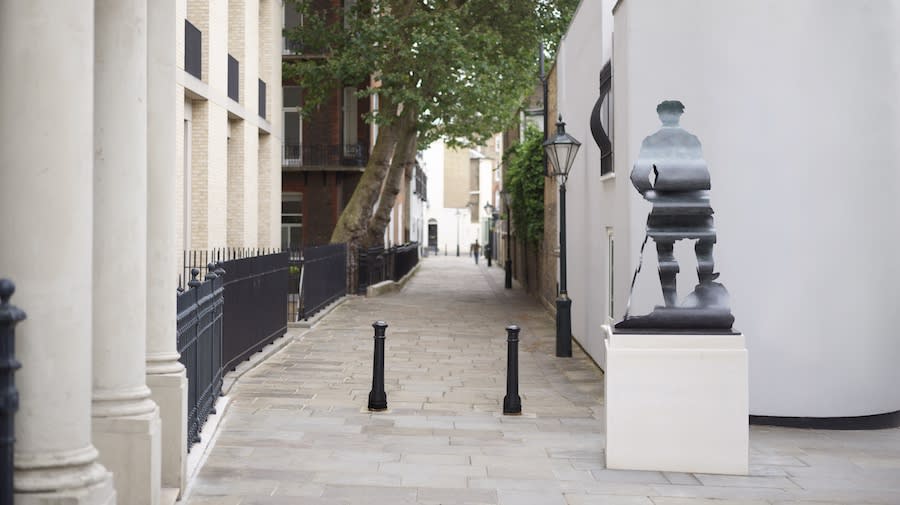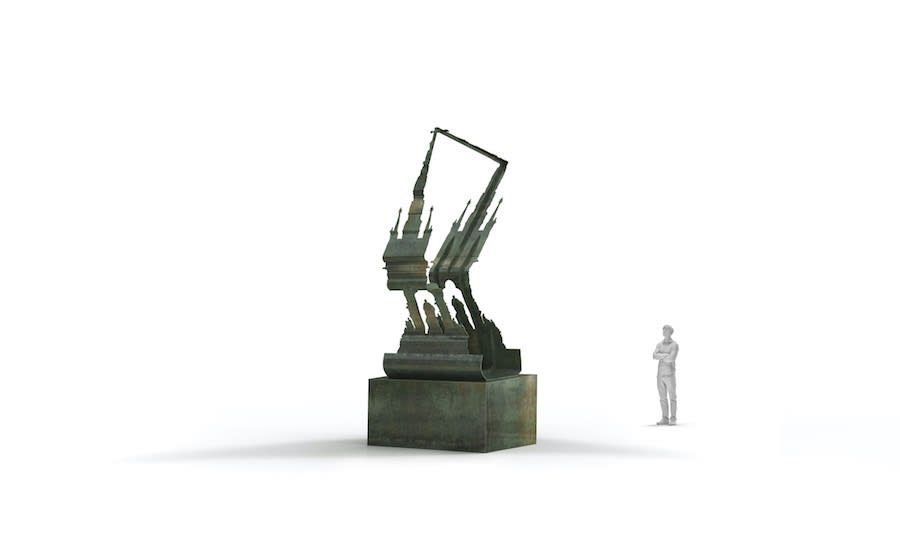Nick Hornby: Interview of the Month, August 2023 – Paul Carey-Kent
You will soon be able to follow a London trail of three major public sculptures made by Nick Hornby. As he explains, ‘they have the guise of tradition but are, in fact, far from traditional: they unravel tropes of the monument, but in a way which is accessible and, I hope, not too didactic. I want the viewer to be in conversation with these forms, to feel they are in on the question.’ It seemed a good time to talk to Hornby in his London studio.
You'll soon have three permanent public sculptures in London. How did that come about?
In the 2010’s I was shortlisted for several commissions, but lost out to more established artists. In 2019 I won my first public commission. My somewhat cheeky pitch was to say: you’ve just had proposals typical of the main options for a public sculpture - a man on a chair and a shiny blob. The first, a memorial, may be accessible to the public but is deeply problematic, stumbling on critical questions about who is being represented and by whom. The second, an abstraction, avoids those pitfalls, but at the cost of being ‘just another of those’ kinds of nonspecific abstract sculpture. So I suggested we present that dilemma as a question – by taking Michelangelo’s ‘David’, the apotheosis of human perfectibility, and intersecting that with an abstract line from Kandinsky, one of the first artists to set out “theory” behind abstraction. That intersection became ‘Twofold’, in Harlow. Completing that sculpture made a huge difference: once I had shown that I could be trusted to actually deliver a massive and structurally complicated public sculpture, I was quickly shortlisted for three other commissions – and won them all. Those successes reinforced my belief in the series—it seemed other people found something compelling in these new sculptures too.
We can already see ‘Power over others is Weakness disguised as Strength’ opposite St James’s Park tube station and ‘Here and there’ close to the Albert Memorial. ‘Do It All’ will be unveiled in Kensington Gardens on 27 September. What do they address?
The first critiques the trope of the equestrian statue, the second deals with the monumental figure in the urban landscape, and the third combines the silhouette of the Albert Memorial with the profile of Nefertiti, perhaps the most powerful woman in ancient history. Collectively they pose the question: what does a monument mean in the 21st century? Each sculpture asks that question from a very particular site, and embodies my enduring interest in form, material and objectness.
How do they emerge from your long-running sculptural concerns?
From 2010 onwards, I devised a system for intersecting components from multiple trajectories. It wasn’t like making a mixture – as when, if you bake a cake, the egg, butter and flour transform and become something new. My process creates a new, synthetic form, but from certain vantage points you can still see the original elements. I like to make an object which is hermetically sealed yet still unfolds.
How does ‘Power over others is weakness disguised as strength’ operate?
The artwork responds to its surroundings —Westminster, a national seat of power, where sculptures of men on horseback are numerous. But if those statues celebrate power, this sculpture challenges it through two visual quotations. The first references a statue located outside the Palace of Westminster. On that site there’s a nineteenth-century celebratory depiction of Richard I, unveiled during a period of Industrialisation and Imperialism. The second is a reference from Laurence Sterne’s experimental novel ‘Tristram Shandy’. In the book, a curling line suddenly interrupts the printed text. It describes a conversational gesture, where the speaker waves his stick in the air to describe the experience of freedom. The line escapes the confines of words and embodies the freedom it describes. The presence of that line in this sculpture invites us to think about storytelling, history and the fictions that support the figures we turn into statues. If this sculpture repeats the image of Richard I, it is to suggest the fragility of power and its monuments. After all, he is only visible from certain angles. From others, the image collapses: the figure of power is toppled within his own statue.
And the title – a quote from Eckhart Tolle - points towards that meaning?
Yes—in the public realm, I really wanted to avoid misinterpretation: this is a critique of the equestrian statue format, rather than a celebration of Richard I. To shine a light on this subject, I had to incorporate an image of the very thingI’m trying to critique. I was sensitive to the fact that you do clearly see his image at a certain point – so I wanted to make it abundantly clear that I’m trying to propose an alternative, and not celebrating military men on horses.
So there is a collage of timelines?
My relationship to time is very flattening – things like love, betrayal and sex are timeless, and you can access just as much truth in something from 500 years ago as today. So here I combine several times into a sort of flat object: a 12th century king, a depiction of him from 1850, a line from Tristram Shandy (published in 1759), and a title from 1997, all in a 21st century sculpture.
What comes together in ‘Here and There’?
The same line from Sterne – literally a ‘literal’ thread between the sculptures – is combined with the 1818 figure of the Wanderer from Caspar David Friedrich’s famous painting. The sculpture is very close to the Albert Memorial, which in turn connects it to ‘Do It All’. You see ‘Here and There’ first from far down the road, when it looks like a classic monument of man on a plinth, but as you get closer it unravels into Sterne’s line. The Wanderer in the painting is looking out from the top of mountain, and is art school fodder as it stands in for the sublime as that mad meeting point between fear and beauty. It’s also strange because we only see back of the man. It’s about presence and distance, and I want to reorient viewer to include the park. There’s also a personal connection: my father has late stage Alzheimer’s, and I am increasingly dwelling on memories. I have exquisitely precious childhood memories of sailing model boats on Hyde Park Pond, when model boats seemed huge and the pond oceanic, so I think that’s where the Lilliputian play with scale comes from.
‘Tristram Shandy’ is clearly important to you?
I can trace my practice back to structuralists and the epiphany of reading Saussure, Barthes and Derrida at art school. Tristram Shandy fits with that: it’s non-linear, full of distractions and anecdotes, the first book to make the visual layout of words on the page a component – really the start of modernism. And I love that line for being neither text nor image – not a word, and yet not a drawing.
‘Do It All’ refers to the former chain of DIY shops, operating 1963-2001. Why so?
In 1988 the post-modern architect Ian Pollard designed the extraordinay and wonderful Egyptian revival Homebase on Warwick Road. It was perfect example of postmodernism – a basic rectangular warehouse with a theatrical cladding. I grew up close by and as a child this was my DIY store. I would regularly buy timber and electronics from the then Homebase. Like tea-drinking, I feel DIY is a classic British institution. Sadly, the building was knocked down but is now the site for the development and my sculpture. The brief for this commission asked the artists to refer to one of the ten historical figures the new buildings were named after. I was rather shocked to see they were all Victorian men. By chance, Howard Carter, who discovered King Tutankhamun, was one of them, which brought me right back to the mock-Egyptian Homebase that I loved so much. In opposition to Prince Albert, I juxtaposed the incredible and iconic head of Nefertiti. The sculpture's other component is the Albert Memorial: as a neo-Gothic Victorian monument it has a post-modern quality to it in as much as one period is imitating another. And it is problematic too, with inappropriate depictions from the corners of the Commonwealth around the outside. My goal is to shine a light on contrasting architectural styles and what lies behind them.
Finally, how are these works made?
The process is incredibly exciting and intrinsically linked to conceptual backbone of the series. Two of he works are fabricated from flat sheet metal (corten or bronze). Where these sculptures are pitting two contrary images against one another, the mode of fabrication has two distinct steps. The objects are designed parametrically (scripted in code and text), and the resulting 3D object is then digitally flattened into distorted 2D pieces. These pieces are laser-cut from sheet metal (corten or bronze) and then, under huge mechanical force, manipulated from their distortions back into their correct forms, where they are wielded together by hand. The laser cutting is rapid, with pin-point accuracy whereas the manipulation is a slow exertion of huge force. The sculptures are collaborative effort between myself, my engineers (The Structure Workshop) and the fabricator (Benson Sedgewick).
….And the materials?
All three are metallic - Two are Bronze and one is Corten. Bronze is the traditional material for historic monuments and is a material loaded with history and associations. The equestrian work is in corten – which is ostensibly a “rusty steel”—which sets up a clearer material distance from the from the monument being referenced. Corten is, in some respects, industrial and yet its hues are warm an earthy, which makes it a somewhat curious material. “Corten protects itself by developing a rust-surface. The rust becomes a protective barrier, like a scab which is stronger than the original material,. What appears to be self destructive in fact creates resilience – perhaps like a self-toppling statue - the fragility is the strength of this sculpture.
Go to Nick Hornby’s website for more about his public sculptures and his work as a whole.






